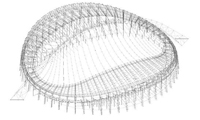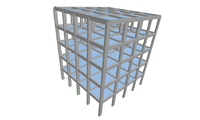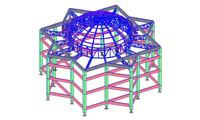STAAD.Pro
 Overview:
Overview:
STAAD is the abbreviation for Structural Analysis And Design. STAAD.Pro is one of the popular software that is used for analyzing & designing structures like – buildings, towers, bridges, industrial, transportation and utility structures. Designs may include any building structures like tunnels, culverts, bridges, piles, petrochemical plants; and building materials like timber, concrete, steel, cold-formed steel, and aluminum.
STAAD or STAAD.Pro was developed by Research Engineers International at Yorba Linda, CA in 1997.
To get rid of the boring & time-consuming manual procedures Structural Engineers started using automated software STAAD.Pro.
 Why to learn?
Why to learn?
STAAD.Pro provides flexible modeling environment, fluent data collaboration, and advanced features. It best structural analysis & design software that supports Indian as well as all international codes.
STAAD.Pro permits structural engineers to design & analyze any type of structure virtually. Structural consultants, structural engineering firms, departments in construction companies, government agencies, owner/operators, offshore platform designers, many more are extensively using this software.
 Learning Objectives:
Learning Objectives:
CADD Center will help you to ace the associated features of STAAD.Pro:
The course will cover all the steps involved in structural analysis & designing of concrete & steel.
This course will introduce one to STAAD.Pro’s state of the art user interface, prevailing analysis and design engines with a sophisticated finite element (FEM), visualization tools, and dynamic analysis capabilities.
Some of the features that we focus in training include:
- Model Generation: Generation of an interactive menu-driven model with concurrent 3D display 2D & 3D graphics generation using rectangular or polar coordinate systems Segments of repetitive geometry used to generate complex structural models.
- Model Verification: 2D/3D drawings on screen and printer/plotter full 3D shapes for frames, elements Isometric or any rotations for full 3D viewing.
- Static Analysis: 2D/3D analysis on the basis of state-of-the-art Matrix method to handle extremely large work. Linear, non-linear, p-delta analysis with automatic load & stiffness correction.
- Dynamic/Seismic Analysis: Mass modeling, frequency, and mode shape Response spectrum extraction, analysis of time history Modal damping ratio for individual models.
- Secondary Analysis: Finite element capabilities, concrete design, steel design, and timber design. Forces & displacements at sections between nodes. Maximum & minimum force envelopes.
 Learning Outcome:
Learning Outcome:
- Student will be able to complete object-oriented instinctive 2D/3D graphic model generation.
- Student will learn to use pull-down menus, tool-tip help, and floating toolbars.
- Student will be able for carrying out flexible zooms and multiple views.
- Student will know to make isometric & perspective views and 3D shapes.
- Student will know the use of simple command language and built-in command file editor.
- Student will learn how to generate graphics/text input.
- Student will be able to do efficient algorithm that will minimize disk space requirements.
- Student will learn to take presentation quality printer plots of geometry and results as part of the run output.
- Student will be able to perform accurate and numerically efficient plate/shell element incorporating out-of-plane shear & in-plane rotation; automatic element mesh generation; comprehensive element stress output including in-plane stresses, out-of-plane shear, bending & principal stresses at nodal, as well as, user-specified points.
- Student will learn how to achieve user-specified design parameters to customize a design.
- Student will know to perform code check, member selection and optimized member selection consisting of analysis/design cycles.
- Student will be able to design concrete beams/columns/slabs/footings as per all major international codes.
 Overview:
Overview:


 Why to learn?
Why to learn? Learning Objectives:
Learning Objectives: Learning Outcome:
Learning Outcome: